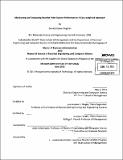| dc.contributor.advisor | Christopher L. Magee and Georgia Perakis. | en_US |
| dc.contributor.author | Ongchin, Derrick Cokee | en_US |
| dc.contributor.other | Leaders for Global Operations Program. | en_US |
| dc.date.accessioned | 2011-09-27T18:37:25Z | |
| dc.date.available | 2011-09-27T18:37:25Z | |
| dc.date.copyright | 2011 | en_US |
| dc.date.issued | 2011 | en_US |
| dc.identifier.uri | http://hdl.handle.net/1721.1/66054 | |
| dc.description | Thesis (M.B.A.)--Massachusetts Institute of Technology, Sloan School of Management; and, (S.M.)--Massachusetts Institute of Technology, Dept. of Electrical Engineering and Computer Science; in conjunction with the Leaders for Global Operations Program at MIT, 2011. | en_US |
| dc.description | Cataloged from PDF version of thesis. | en_US |
| dc.description | Includes bibliographical references (p. 89). | en_US |
| dc.description.abstract | Organizations are quickly realizing the need to leverage data and analytics to stay one step ahead of the competition as fast-paced global markets continue to emerge and grow and the world becomes increasingly complex. More than ever, corporate executives are executing data-driven decisions and strategies to run businesses. They require scenarios and simulations on alternative courses of action that incorporate complex business parameters in order to make decisions that continuously hone customer focus. In an environment of global economic uncertainty, Cisco Systems sees itself entering a time of unprecedented opportunity. With the customer as a leading priority, this thesis investigates the monitoring and evaluation of Cisco's reorder point system in increasing supply chain visibility and driving customer satisfaction excellence. We aim to develop a model that will aid in data-driven decision making and provide an organization the capability to quickly respond to changes in a volatile environment without additional costs or impact to customer experience. The model is intended to serve as a tool to bridge strategy and execution by providing lean process and supply planners invaluable insights into optimizing the inventory management system and improving customer service levels. The model aggregates historical demand data, inventory policy settings, and costweighted item performance to gauge system-wide performance. Model testing accurately corroborates previously known issues of insufficient reorder points. Preliminary user feedback suggests strong initial buy-in within the organization. | en_US |
| dc.description.statementofresponsibility | by Derrick Cokee Ongchin. | en_US |
| dc.format.extent | 107 p. | en_US |
| dc.language.iso | eng | en_US |
| dc.publisher | Massachusetts Institute of Technology | en_US |
| dc.rights | M.I.T. theses are protected by
copyright. They may be viewed from this source for any purpose, but
reproduction or distribution in any format is prohibited without written
permission. See provided URL for inquiries about permission. | en_US |
| dc.rights.uri | http://dspace.mit.edu/handle/1721.1/7582 | en_US |
| dc.subject | Sloan School of Management. | en_US |
| dc.subject | Electrical Engineering and Computer Science. | en_US |
| dc.subject | Leaders for Global Operations Program. | en_US |
| dc.title | Monitoring and evaluating reorder point system performance : a cost-weighted approach | en_US |
| dc.type | Thesis | en_US |
| dc.description.degree | S.M. | en_US |
| dc.description.degree | M.B.A. | en_US |
| dc.contributor.department | Leaders for Global Operations Program at MIT | en_US |
| dc.contributor.department | Massachusetts Institute of Technology. Department of Electrical Engineering and Computer Science | |
| dc.contributor.department | Sloan School of Management | |
| dc.identifier.oclc | 752313516 | en_US |
